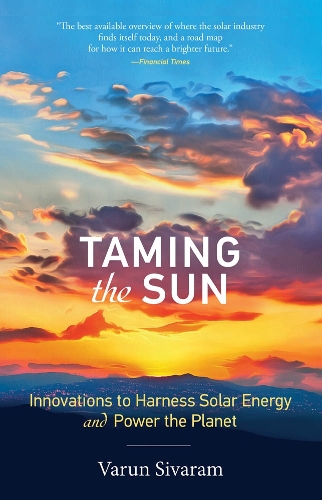
Taming the Sun: Innovations to Harness Solar Energy and Power the Planet
(Paperback)
Publishing Details
Taming the Sun: Innovations to Harness Solar Energy and Power the Planet
By (Author) Varun Sivaram
MIT Press Ltd
MIT Press
26th February 2019
26th February 2019
United States
Classifications
Professional and Scholarly
Non Fiction
Energy resources
333.7923
Physical Properties
Paperback
392
Width 152mm, Height 229mm, Spine 24mm
Description
How solar could spark a clean-energy transition through transformative innovation-creative financing, revolutionary technologies, and flexible energy systems.Solar energy, once a niche application for a limited market, has become the cheapest and fastest-growing power source on earth. What's more, its potential is nearly limitless-every hour the sun beams down more energy than the world uses in a year. But in Taming the Sun, energy expert Varun Sivaram warns that the world is not yet equipped to harness erratic sunshine to meet most of its energy needs. And if solar's current surge peters out, prospects for replacing fossil fuels and averting catastrophic climate change will dim. Innovation can brighten those prospects, Sivaram explains, drawing on firsthand experience and original research spanning science, business, and government. Financial innovation is already enticing deep-pocketed investors to fund solar projects around the world, from the sunniest deserts to the poorest villages. Technological innovation could replace today's solar panels with coatings as cheap as paint and employ artificial photosynthesis to store intermittent sunshine as convenient fuels. And systemic innovation could add flexibility to the world's power grids and other energy systems so they can dependably channel the sun's unreliable energy. Unleashing all this innovation will require visionary public policy- funding researchers developing next-generation solar technologies, refashioning energy systems and economic markets, and putting together a diverse clean energy portfolio. Although solar can't power the planet by itself, it can be the centerpiece of a global clean energy revolution. A Council on Foreign Relations Book
Reviews
The book is not gloomy. It lays out the history, promise, and pitfalls of solar technology with an easy-going lack of wonkishness. But it offers a sobering message that may be as prescientand as readableas Robert Shiller's Irrational Exuberance was before the dotcom and housing crises of the 2000s
The EconomistThe book is both the best available overview of where the industry finds itself today, and a road map for how it can reach that brighter future....
Financial TimesThe first important policy book of 2018.
Bloomberg ViewForeign Affairs Best of Books 2018. Sivaram's enlightening and candid book describes both the enormous progress that has already been made in exploiting solar energy and the major obstacles to further progress.
Sivaram includes a raft of case studies, from current research on the photovoltaic materials called perovskites to Off Grid Electric, a start-up aiming to electrify swathes of Africa by 2019.
NatureTaming the Sun is an even-handed untangling of a situation that can appear a mess of contradictions
Engineering and Technology MagazineAuthor Bio
Varun Sivaram is a physicist and Chief Technology Officer at ReNew Power Ventures, a multibillion-dollar renewable energy firm that is India's largest. He is also a senior research scholar at the Columbia University Center for Global Energy Policy and a board member for the Stanford University's energy and environment intitutes. Most recently, he was the science and technology fellow at the Council on Foreign Relations, where he directed the Program on Energy Security and Climate Change, and an Adjunct Professor at Georgetown University, where he taught "Clean Energy Innovation." He has also served as senior energy advisor to the Los Angeles Mayor and New York Governor's Office, and as a consultant at McKinsey & Company. PV Magazine called him "The Hamilton of the Solar Industry," Forbes named him one of its 30 under 30, and Grist selected him as one of the top 50 leaders in sustainability. He is the editor of the book Digital Decarbonization- Promoting Digital Innovations to Advance Clean Energy Systems. He holds a PhD in condensed matter physics from Oxford University, where he was a Rhodes Scholar.
